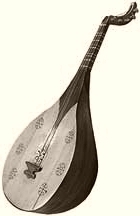
Back بربط Arabic Bərbət Azerbaijani Barbat (Musikinstrument) German بربت Persian Barbat (instrument) French Barbat Italian Барбет (музыкальный инструмент) Russian Барбат Tajik Berbet Turkish Барбат (музичний інструмент) Ukrainian
 Modern barbat with six courses of strings. | |
| String instrument | |
|---|---|
| Classification | Plucked string instrument |
| Related instruments | |
The barbat (Persian: بربت) or barbud is a lute of Greater Iranian or Persian origin, and widespread across Central Asia, especially since the Sassanid Empire.[1] Barbat is characterized as carved from a single piece of wood, including the neck and a wooden sound board.[1] Possibly a skin-topped instrument for part of its history, it is ancestral to the wood-topped oud and biwa and the skin-topped Yemeni qanbus.[1][2][3][4]
Although the original barbat disappeared, modern Iranian luthiers have invented a new instrument, inspired by the Barbat.[5] The modern re-created instrument (Iranian Barbat) resembles the oud, although differences include a smaller body, longer neck, a slightly raised fingerboard, and a sound that is distinct from that of the oud.[5]
- ^ a b c During, Jean (15 December 1988). "Encyclopaedia Iranica - Barbat". Iranicaonline.org. Retrieved 2012-02-04.
- ^ Lawergren, Bo; Farhat, Hormoz; Blum, Stephen (20 January 2001). "Iran". Grove Music Online. Vol. 1. doi:10.1093/gmo/9781561592630.article.13895.
The 'ūd (lute) is believed to be a later development of a pre-Islamic Persian instrument called barbat.
- ^ Cite error: The named reference
centralasiawas invoked but never defined (see the help page). - ^ Hilarian, Larry Francis (2003). "Documentación y rastreo histórico del laúd malayo (gambus)" [Documentation and historical tracking of the Malay lute (gambus)]. Desacatos (in Spanish) (12): 78–92.
El gambus melayu que ahí llegó podría ser, o bien un descendiente directo del barbat persa, o del qanbus yemenita, que a su vez evolucionó del barbat.[translation: The melayu gambus that arrived there could be either a direct descendant of the Persian barbat, or the Yemenite qanbus, which in turn evolved from the barbat.]
- ^ a b Goldrick, Navid (16 August 2013). "Persian Oud – Barbat". majnunn music and dance. Archived from the original on 4 December 2019. Retrieved 31 March 2018.
In the last 40 years...luthiers in Iran have been conducting research on old paintings... to best reproduce the Barbat of old.